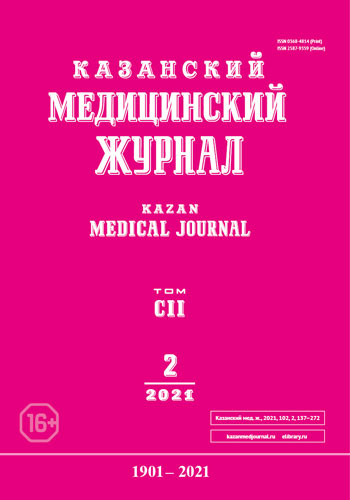Особенности клинического течения мочекаменной болезни у пациентов с первичным гиперпаратиреозом
- Авторы: Баранова И.А.1, Зыкова Т.А.1, Баранов А.В.1,2
-
Учреждения:
- Северный государственный медицинский университет
- Череповецкий государственный университет
- Выпуск: Том 102, № 2 (2021)
- Страницы: 192-198
- Раздел: Теоретическая и клиническая медицина
- Статья получена: 13.02.2021
- Статья одобрена: 15.03.2021
- Статья опубликована: 06.04.2021
- URL: https://kazanmedjournal.ru/kazanmedj/article/view/60814
- DOI: https://doi.org/10.17816/KMJ2021-192
- ID: 60814
Цитировать
Аннотация
Цель. Оценить частоту мочекаменной болезни и выявить особенности её клинического течения у пациентов с первичным гиперпаратиреозом.
Методы. Ретроспективно проанализировано 48 историй болезней пациентов с установленным диагнозом первичного гиперпаратиреоза. Средний возраст пациентов составил 57 [53; 61] лет. При оценке историй болезни изучали анамнез заболевания, жалобы при поступлении, клиническую картину, результаты лабораторных анализов и инструментального обследования. Пациенты были разделены на группу с наличием нефролитиаза (n=33) и группу без нефролитиаза (n=15). Осуществляли определение статистической значимости различий сравниваемых показателей в двух группах (по критерию Манна–Уитни).
Результаты. Среди пациентов с первичным гиперпаратиреозом мочекаменная болезнь выявлена у 69% больных, из них женщины в постменопаузальном периоде составили 90%. Течение нефролитиаза у этих пациентов характеризовалось частым рецидивированием с преобладанием двустороннего поражения почек (62%). Длительность течения нефролитиаза до установления диагноза первичного гиперпаратиреоза составила 6 [1; 19] лет, это осложнение часто было первым проявлением заболевания. По данным инструментальных исследований почек у пациентов с нефролитиазом в 42% случаев обнаружены небольшие конкременты до 5 мм в диаметре, в 15% случаев — бессимптомные камни почек. Тяжёлое осложнение в виде коралловидного нефролитиаза зафиксировано у 2 (10%) пациентов. В группе пациентов с нефролитиазом отмечено более высокое содержание общего кальция крови (р=0,022) и паратгормона (р=0,007) по сравнению с пациентами без нефролитиаза на фоне первичного гиперпаратиреоза.
Вывод. Мочекаменная болезнь бывает частым осложнением при первичном гиперпаратиреозе; наличие нефролитиаза ассоциировано с более выраженными изменениями фосфорно-кальциевого обмена, а также характеризуется частым бессимптомным течением, что требует внимания специалистов к этому виду осложнений при первичном гиперпаратиреозе.
Полный текст
Об авторах
Ирина Александровна Баранова
Северный государственный медицинский университет
Автор, ответственный за переписку.
Email: baranov.av1985@mail.ru
Россия, г. Архангельск, Россия
Татьяна Алексеевна Зыкова
Северный государственный медицинский университет
Email: baranov.av1985@mail.ru
Россия, г. Архангельск, Россия
Александр Васильевич Баранов
Северный государственный медицинский университет; Череповецкий государственный университет
Email: baranov.av1985@mail.ru
Россия, г. Архангельск, Россия; г. Череповец, Россия
Список литературы
- Надеева Р.А., Камашева Г.Р., Амиров Н.Б. Гиперпаратиреоз и мочекаменная болезнь: ошибки диагностики (клинический случай). Вестн. соврем. клин. мед. 2016; 9 (6): 163–168. doi: 10.20969/VSKM.2016.9(6).163-168.
- Имамвердиев С.Б., Гусейн-заде Р.T. Возможность влияния эпидемиологических факторов риска при формировании мочекаменной болезни. Терапевтич. арх. 2016; 88 (3): 68–72. doi: 10.17116/terarkh201688368-72.
- Агаронян А.В., Сатыбалдыев В.М., Мануйлов В.М. Медико-социальная составляющая развития и лечения мочекаменной болезни у военнослужащих северного флота. Экология человека. 2008; (11): 42–47.
- Клинические рекомендации. Мочекаменная болезнь. Российское общество урологов. 2019; 73 с. https://pharm-spb.ru/docs/lit/Urologia_Rekomendazii%20po%20diagnostike%20i%20lecheniyu%20mochekamennoi%20bolezni%20(ROU,%202019).pdf (дата обращения: 02.02.2021).
- Дедов И.И., Мельниченко Г.А., Мокрышева Н.Г., Рожинская Л.Я., Кузнецов Н.С., Пигарова Е.А., Воронкова И.А., Липатенкова А.К., Егшатян Л.В, Мамедова Е.О., Крупинова Ю.А. Клинические рекомендации. Первичный гиперпаратиреоз: клиника, диагностика, дифференциальная диагностика, методы лечения. Пробл. эндокринол. 2016; 62 (6): 40–77. doi: 10.14341/probl201662640-7.
- Рожинская Л.Я., Ростомян Л.Г., Мокрышева Н.Г., Мирная С.С., Кирдянкина Н.О. Эпидемиология первичного гиперпаратиреоза. Леч. врач. 2010; 11: 50–56.
- Дедов И.И., Рожинская Л.Я., Мокрышева Н.Г., Васильева Т.О. Этиология, патогенез, клиническая картина, диагностика и лечение первичного гиперпаратиреоза. Остеопороз и остеопатии. 2010; 13 (1): 13–18. doi: 10.14341/osteo2010113-18.
- Перетокина Е.В., Мокрышева Н.Г. Нефролитиаз при первичном гиперпаратиреозе, современный взгляд. Ожирение и метаболизм. 2014; (3): 3–8. doi: 10.14341/OMET201433-8.
- Verdelli С., Corbetta S. Kidney involvement in patients with primary hyperparathyroidism: an update on clinical and molecular aspects. Eur. J. Endocrinol. 2017; 176: R39–R52. doi: 10.1530/EJE-16-0430.
- Рожинская Л.Я., Ростомян Л.Г., Мокрышева Н.Г., Мирная С.С., Кирдянкина Н.О. Эпидемиологические аспекты первичного гиперпаратиреоза в России. Остеопороз и остеопатии. 2010; (3): 13–18.
- Borretta G., Gianotti L., Cesario F., Borretta V., Tassone F. Renal function in primary hyperparathyroidism. G. Ital. Nefrol. 2010; 27 (Suppl. 50): S91–S95. PMID: 20922703.
- Bilezikian J.P., Brandi M.L., Eastell R., Shonni J., Silverberg S.J., Udelsman R., Marcocci C., Potts Jr.J.T. Guidelines for the management of asymptomatic primary hyperparathyroidism: summary statement from the Fourth International Workshop. J. Clin. Endocrinol. Metab. 2014; 99 (10): 3561–3569. doi: 10.1210/jc.2014-1413.
- Баранова И.А., Зыкова Т.А., Сергеева О.А. Сравнительный анализ клинических проявлений первичного гиперпаратиреоза по результатам госпитализаций и скрининга на гиперкальциемию в Архангельской области. Мед. вестн. Юга России. 2019; 10 (4): 36–42. doi: 10.21886/2219-8075-2019-10-4-36-42.
- Дедов И.И., Мокрышева Н.Г., Мирная С.С., Ростомян Л.Г., Пигарова Е.А., Рожинская Л.Я. Эпидемиология первичного гиперпаратиреоза в России (первые результаты по базе данных ФГУ ЭНЦ). Пробл. эндокринол. 2011; 57 (3): 3–10. doi: 10.14341/probl20115733-10.
- Suh J.M., Cronan J.J., Monchik J.M. Primary hyperparathyroidism: Is there an increased prevalence of renal stone disease. Am. J. Roentgenol. 2008; 191 (3): 908–911. doi: 10.2214/AJR.07.3160.
- Cipriani C., Biamonte F., Costa A.G., Zhang C., Biondi P., Diacinti D., Pepe J., Piemonte S., Scillitani A., Minisola S., Bilezikian J.P. Prevalence of kidney stones and vertebral fractures in primary hyperparathyroidism using imaging technology. J. Clin. Endocrinol. Metab. 2015; 100 (4): 1309–1315. doi: 10.1210/jc.2014-3708.
Дополнительные файлы








